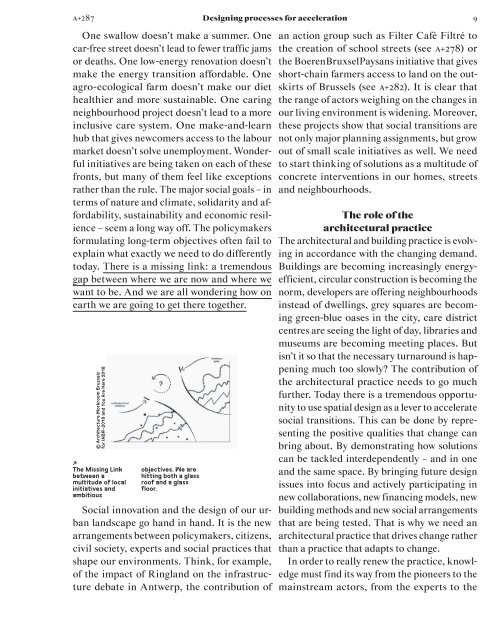A+287 Article: Building bridges by Hanne Mangelschots and Serafina Van Godtsenhoven
You also want an ePaper? Increase the reach of your titles
YUMPU automatically turns print PDFs into web optimized ePapers that Google loves.
a+287 Designing processes for acceleration<br />
9<br />
One swallow doesn’t make a summer. One<br />
car-free street doesn’t lead to fewer traffic jams<br />
or deaths. One low-energy renovation doesn’t<br />
make the energy transition affordable. One<br />
agro-ecological farm doesn’t make our diet<br />
healthier <strong>and</strong> more sustainable. One caring<br />
neighbourhood project doesn’t lead to a more<br />
inclusive care system. One make-<strong>and</strong>-learn<br />
hub that gives newcomers access to the labour<br />
market doesn’t solve unemployment. Wonderful<br />
initiatives are being taken on each of these<br />
fronts, but many of them feel like exceptions<br />
rather than the rule. The major social goals – in<br />
terms of nature <strong>and</strong> climate, solidarity <strong>and</strong> affordability,<br />
sustainability <strong>and</strong> economic resilience<br />
– seem a long way off. The policymakers<br />
formulating long-term objectives often fail to<br />
explain what exactly we need to do differently<br />
today. There is a missing link: a tremendous<br />
gap between where we are now <strong>and</strong> where we<br />
want to be. And we are all wondering how on<br />
earth we are going to get there together.<br />
© Architecture Workroom Brussels<br />
for IABR–2018 <strong>and</strong> You Are Here 2018<br />
The Missing Link<br />
between a<br />
multitude of local<br />
initiatives <strong>and</strong><br />
ambitious<br />
objectives. We are<br />
hitting both a glass<br />
roof <strong>and</strong> a glass<br />
floor.<br />
Social innovation <strong>and</strong> the design of our urban<br />
l<strong>and</strong>scape go h<strong>and</strong> in h<strong>and</strong>. It is the new<br />
arrangements between policymakers, citizens,<br />
civil society, experts <strong>and</strong> social practices that<br />
shape our environments. Think, for example,<br />
of the impact of Ringl<strong>and</strong> on the infrastructure<br />
debate in Antwerp, the contribution of<br />
an action group such as Filter Café Filtré to<br />
the creation of school streets (see a+278) or<br />
the BoerenBruxselPaysans initiative that gives<br />
short-chain farmers access to l<strong>and</strong> on the outskirts<br />
of Brussels (see a+282). It is clear that<br />
the range of actors weighing on the changes in<br />
our living environment is widening. Moreover,<br />
these projects show that social transitions are<br />
not only major planning assignments, but grow<br />
out of small scale initiatives as well. We need<br />
to start thinking of solutions as a multitude of<br />
concrete interventions in our homes, streets<br />
<strong>and</strong> neighbourhoods.<br />
The role of the<br />
architectural practice<br />
The architectural <strong>and</strong> building practice is evolving<br />
in accordance with the changing dem<strong>and</strong>.<br />
<strong>Building</strong>s are becoming increasingly energyefficient,<br />
circular construction is becoming the<br />
norm, developers are offering neighbourhoods<br />
instead of dwellings, grey squares are becoming<br />
green-blue oases in the city, care district<br />
centres are seeing the light of day, libraries <strong>and</strong><br />
museums are becoming meeting places. But<br />
isn’t it so that the necessary turnaround is happening<br />
much too slowly? The contribution of<br />
the architectural practice needs to go much<br />
further. Today there is a tremendous opportunity<br />
to use spatial design as a lever to accelerate<br />
social transitions. This can be done <strong>by</strong> representing<br />
the positive qualities that change can<br />
bring about. By demonstrating how solutions<br />
can be tackled interdependently – <strong>and</strong> in one<br />
<strong>and</strong> the same space. By bringing future design<br />
issues into focus <strong>and</strong> actively participating in<br />
new collaborations, new financing models, new<br />
building methods <strong>and</strong> new social arrangements<br />
that are being tested. That is why we need an<br />
architectural practice that drives change rather<br />
than a practice that adapts to change.<br />
In order to really renew the practice, knowledge<br />
must find its way from the pioneers to the<br />
mainstream actors, from the experts to the


















